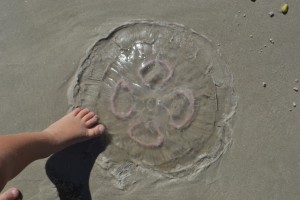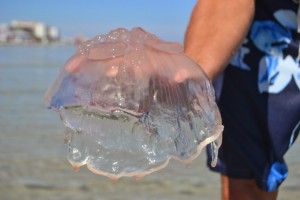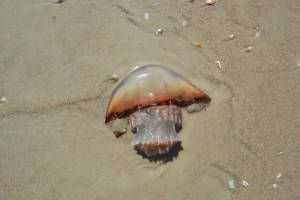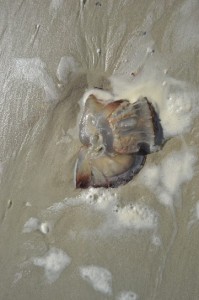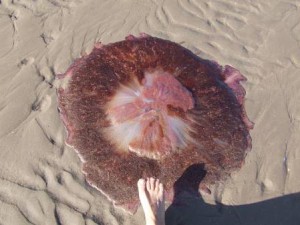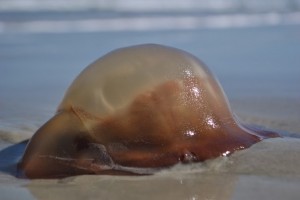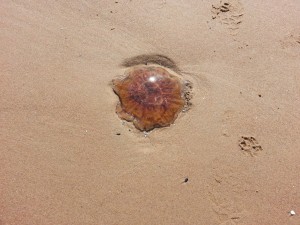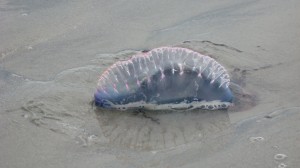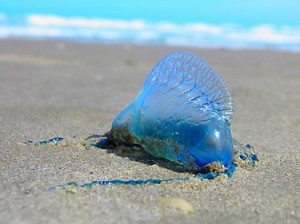Jellyfish On New Smurna Beach
Jellyfish on the Beach in Florida
Every now and then Jellyfish will come ashore or be in the water near to shore along the Florida coast. This happens from Jacksonville, Miami to Clearwater and the Panhandle. This also happens in new Smyrna Beach. But are these beautiful creature dangerous, what are they and are there times of the year that they are more prevalent than others? In September I took a series of pictures of Jellyfish which had washed up on the beach.
Types Of Jellyfish
There are 10 types of Jellyfish which can be found on Florida’s East coast: Moon Jellyfish (Aurelia aurita), Cannonball Jellyfish or Cabbagehead Jellyfish (Stomolophus Meleagris) , Portuguese Man-of-War (Physalia Physalis), Sea Nettle Jellyfish (Chrysaora), Blue Button Jellyfish (Porpita Porpita), By-The-Wind Sailor Jellyfish (Velella), Mushroom Cap Jellyfish, Mauve Stinger (Pelagia Noctiluca), Box Jellyfish (Cubozoa).
Are Jellyfish Dangerous
In New Smyrna Beach, if you see a Purple flag flying near the Lifeguard station – it indicates Dangerous Marine Life. Many times this indicates that Jellyfish are in the water and to be aware of it. If this is the case – can you swim in the water with jellyfish in it? What about the Jellyfish on the beach? Is it too dangerous to step on, or pick up Jellyfish on the beach?
Remember the Jellyfish sting is actually microscopic barbed stingers on their tentacles, also known as Nematocysts. When your skin comes into contact with these stingers they penetrate the skin and release the venom inside them.
…first lets have a look at the different types and see which to avoid:
Moon Jellyfish (Aurelia aurita)
The Moon Jellyfish (Aurelia aurita) are not dangerous.
Can a Moon Jellyfish sting you? Yes it can, but most people agree that the sting is extremely mild and that most people would not feel the sting by this Jellyfish even if stung. The picture above is of my 3 year old prodding the Jelly fish with her toe, and me handling it. The day these very beautiful Jellyfish washed up on the beach we also saw many in the water.
Cannonball Jellyfish or Cabbagehead jellyfish (Stomolophus meleagris)
Not only is the Cannonball Jellyfish not dangerous, you can eat them.
So can the Cannonball Jellyfish sting? Yes they do sting, however the sting is so mild that you would most likely not feel it. So these creatures are not harmful to man. Man and loggerhead turtles, on the other hand … can and do eat these Jellies. At eatingjellyfish.com you will find several links to recipes online. Just remember not to eat those that you sinf washed up on the beach as you don’t know ow fresh they are. We saw Jellyfish was up on the beach for more than a week and I am pretty sure the tide was carrying these same, now dead, Jellyfish back out with the tide, then back in the next day.
Lion’s Mane Jellyfish (Cyanea capillata)
Lion’s Mane Jellyfish are moderately dangerous, their sting is quite mild.
These Jellyfish are found more in the winter months when there are relatively few people in the water. Their sting is considered more of a slight burning sensation than a sting. These Jellyfish can be found further north and have been found to be up to 7 feet in diameter. Seeing these on the beach is extremely rare, seeing as 7 foot specimen … well that is a world record, so call Guinness if you find one larger.
Sea Nettle Jellyfish (Chrysaora)
Sea Nettles are moderately dangerous, their sting is quite mild.
These Jellyfish are not a common Jellyfish to be found in the waters off New Smyrna Beach. Although they do like both warm and cooler water they are more commonly found in the northwest of America. Because it is the nematocysts that are found all along the sea nettle’s tentacles that sting it is easier to accidentally brush up against this type of Jellyfish in the water and get stung.
Mauve Stinger (Pelagia noctiluca)
Mauve Stinger are moderately dangerous, their sting is quite mild.
The Mauve Stinger likes warm water and can be found in the Atlantic ocean and all down the Space Coast, although like Sea Nettle it is quite rare to see them on the beach in New Smyrna. It’s name mean having the ability to glow in the dark. This Jellyfish is known to beach in great numbers as this 2011 story in the New York Times will attest to.
Portuguese man-of-war or Bluebottle (Physalia physalis)
Portuguese man-of-war is very dangerous, their sting is quite m.
The Portuguese man-of-war is called that because of the ‘bottle’ that sits on top of the water. It is this polyp that looks similar to an old war ship at full sail. An interesting thing about this Jellyfish is that in fact it is not a Jellyfish, and not even one organism but rather an animal made up of a colony of organisms working together. This ‘Jellyfish’, although exotic and the most beautiful blue I have ever seen in nature – it’s sting can “make a grown man cry” or “kill a small fish” so it is best to avoid these little creatures. The tentacles that sting and lie beneath the ‘bottle’ can grow up to 165 feet long. And lastly, these stinging machines do not lose any of their potency once they wash up on the shore. DO NOT pick up a Portuguese man-of-war off the beach – it will sting you.
What Can You Do If You Get Stung By A Jellyfish
Remove the Jellyfish Tentacles From Your Skin:
As long as the Jellyfish is attached to your skin it will keep releasing venom onto your skin. You can use a stick, shell, towel or even sand to remove the tentacles. Once removed, wash off the skin with seawater to make sure that all tentacles have been removed from the skin.
What Can you Put On A Jellyfish Sting To Treat The Burn:
First Do Not Treat A Jellyfish Sting With Alcohol, unless the sting hurts so much you need a quick shot of something. Putting alcohol on a Jellyfish sting will make make the sting worse. Also and Do NOT Pee on the area
here is a list that have proven to work in order of popularity
- Vinegar (not on Sea Nettle Jellyfish stings- it will make it worse)
- Meat Tenderizer
- Sodium Bicarbonate or baking soda
- Shaving cream
- Talcum powder
- Calamine lotion
If you do get stung and you treat the sting quickly the pain can subside within minutes, however some severe stings can take weeks to recover from.
Jelly Fish Videos
Southern Moon Jelly(Aurelia Marginalis) Video

